Blood Thinner Bleeding Emergency Checker
When to Seek Emergency Care
This tool helps determine if your symptoms require immediate medical attention. Based on guidelines from the article, select any symptoms you're experiencing.
Taking a blood thinner can feel like walking a tightrope. You’re on it because your doctor said it could save your life-preventing a stroke, heart attack, or pulmonary embolism. But every day, you worry: is this cut going to bleed too long? Is that nosebleed normal? What if I fall and hit my head? The fear isn’t irrational. About 3 in 100 people on blood thinners have a major bleeding event each year. And while most bleeding isn’t life-threatening, knowing the difference between a nuisance and a crisis can mean the difference between a quick fix and an emergency room visit-or worse.
What Blood Thinners Actually Do
Blood thinners-also called anticoagulants-don’t make your blood thinner like water. They slow down how quickly clots form. That’s good when you have atrial fibrillation, a deep vein clot, or a mechanical heart valve. But it means even small injuries take longer to stop bleeding. Common types include warfarin (Coumadin), apixaban (Eliquis), dabigatran (Pradaxa), rivaroxaban (Xarelto), and heparin. Newer ones, called DOACs, are now used more than warfarin because they don’t need constant blood tests and have fewer food interactions. But they still carry bleeding risk. Apixaban has the lowest major bleeding rate among them-about 2.1 events per 100 people each year. Warfarin? Around 3.8.
That’s why it’s not about avoiding bleeding altogether. It’s about recognizing when it becomes dangerous.
When Bleeding Is Just a Nuisance
Let’s get real: most bleeding on blood thinners isn’t an emergency. You might notice:
- Nosebleeds that last 10-15 minutes but stop with pressure
- Bleeding gums when brushing your teeth
- Small cuts that take a few extra minutes to clot
- Easy bruising, especially on the arms and legs
These are common. In fact, over half of all ER visits by people on blood thinners are for this kind of stuff. A 2023 survey found that 52% of patients went to the ER for nosebleeds or minor cuts that turned out to be harmless. The problem? Many of them stopped their medication afterward-without talking to their doctor. And that’s dangerous. Stopping your blood thinner for even a few days can spike your risk of a clot by 300% in the first week. One Reddit user, u/ClotSurvivor, shared: “I stopped my blood thinner after a bad cut and had a pulmonary embolism two weeks later. Don’t be like me.”
Here’s what to do for minor bleeding:
- Apply firm, continuous pressure for at least 10 minutes. No peeking. Checking every 30 seconds won’t help.
- Elevate the area if it’s an arm or leg.
- For nosebleeds, pinch the soft part of your nose (not the bridge) for 10-15 minutes. Lean forward, don’t tilt your head back.
- Don’t use hydrogen peroxide or alcohol on cuts-they irritate tissue and slow healing.
Most minor cuts stop bleeding in 5-7 minutes with proper pressure. In someone not on blood thinners? Usually 2-3 minutes. That extra time isn’t a sign of failure. It’s expected.
When to Go to the Emergency Room
Now, here’s what you need to treat like an emergency. If you have any of these, call 000 or go to the nearest ER right away:
- Bleeding that doesn’t stop after 15 minutes of firm, continuous pressure
- Vomiting blood or coughing up blood (bright red or coffee-ground-looking)
- Red or dark brown urine-like cola or tea
- Black, tarry, or bloody stools
- A sudden, severe headache, confusion, vision changes, or weakness on one side of your body (signs of brain bleed)
- Severe, unexplained back or abdominal pain
- Difficulty breathing or chest pain
- Swelling, pain, or warmth in one leg (possible clot, but also possible internal bleeding)
- Any head injury, even if you feel fine-symptoms can appear 24 to 72 hours later
- Menstrual bleeding so heavy you soak through a pad every hour for more than 2 hours
These aren’t guesses. These are signs of internal bleeding-gut, brain, lungs, or abdomen. Blood loss over 15% of your total volume causes dizziness. Over 30%, you’ll feel short of breath. You might not realize how much you’ve lost until you’re collapsing. And once you’re in shock, every minute counts.
Internal bleeding doesn’t always look like a gushing wound. Sometimes it’s just pain, fatigue, or feeling “off.” If you’re on a blood thinner and you feel like you’re fading-go. Don’t wait. Don’t text your doctor. Don’t Google it. Go.
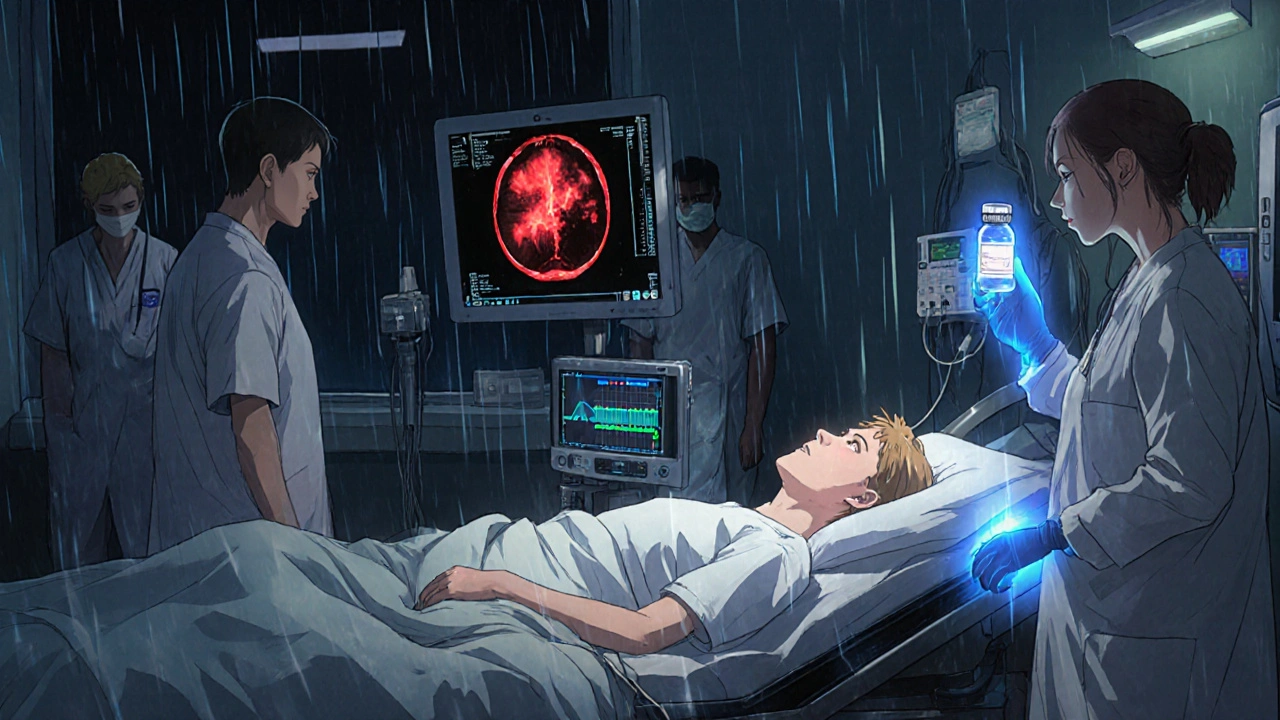
Why Waiting Is Riskier Than Going
Many people delay because they’re scared of the ER. Or they think, “It’s probably nothing.” But here’s the truth: in trauma protocols, uncontrolled bleeding can lead to hypovolemic shock in 30 to 60 minutes. That’s less time than most people spend waiting for a doctor’s appointment.
And here’s something most don’t know: emergency departments now have reversal agents that can stop bleeding fast. Andexanet alfa (Andexxa) reverses apixaban and rivaroxaban in under an hour-down from 3 to 4 hours. A new universal reversal agent, ciraparantag, is expected in 2024. But these only work if you get there in time.
One study found that patients who waited more than 4 hours after a major bleed had 2.5 times higher death rates than those treated within 2 hours.
What Happens When You Go to the ER
If you show up with bleeding concerns, they’ll check your vital signs, ask about your medication, and likely run a blood test called an INR (if you’re on warfarin) or a specific anti-Xa level (for DOACs). If they suspect internal bleeding, you’ll get a CT scan or ultrasound. If you’re bleeding heavily, they’ll give fluids, blood transfusions, or reversal agents.
Don’t be surprised if they ask you to stop your blood thinner temporarily. That’s normal. But they’ll also tell you exactly when and how to restart it. Never restart it on your own. The risk of a clot coming back is real.
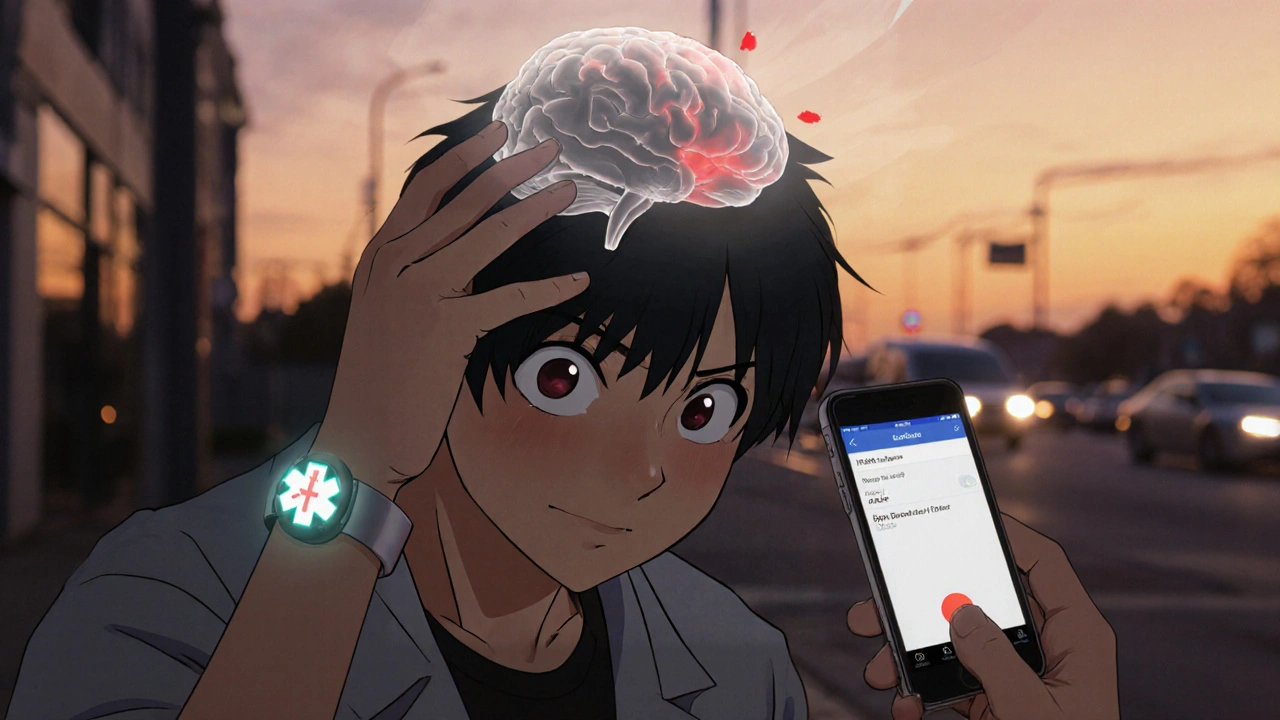
What You Can Do Before It Happens
Prevention beats emergency care every time.
- Wear a medical alert bracelet that says you’re on a blood thinner.
- Keep a list of your meds, doses, and your doctor’s contact info in your phone and wallet.
- Ask your doctor for a written bleeding plan: “What do I do if I get a nosebleed? What if I fall?”
- Use an electric razor, soft toothbrush, and avoid contact sports.
- Know your local ER’s location and how to get there quickly.
- Consider a telehealth consult for minor bleeding. A 2022 study showed patients who used telehealth for bleeding questions reduced unnecessary ER visits by 37%.
And if you’re worried about bleeding, talk to your anticoagulation clinic or pharmacist. Most hospitals have them. They’re trained to help you manage this without panic.
Final Thought: Don’t Stop Your Meds
The biggest mistake people make isn’t ignoring bleeding. It’s stopping their medication because they’re scared of it. The Michigan Anticoagulation Quality Improvement Initiative found that 68% of patients who quit their blood thinner after minor bleeding had a clot within 30 days. Your doctor prescribed this for a reason. The risk of a stroke or clot is far higher than the risk of bleeding-if you manage it right.
Know the signs. Know your plan. Don’t panic over small cuts. But don’t ignore the big ones. When in doubt, go. It’s not overreacting. It’s staying alive.
Can I still take aspirin or ibuprofen while on a blood thinner?
No, unless your doctor specifically says so. Aspirin and ibuprofen can increase bleeding risk even more. Use acetaminophen (paracetamol) for pain instead, but always check with your doctor first. Even some herbal supplements like ginkgo, garlic, or fish oil can interfere. Always tell your doctor about everything you’re taking.
How long should I apply pressure to a cut?
At least 10 minutes-no checking. Use a clean cloth or gauze and press down firmly. It should feel uncomfortable, not just light pressure. If it’s still bleeding after 15 minutes, go to the ER. Most minor cuts stop within 5-7 minutes with proper pressure.
Is it safe to exercise while on blood thinners?
Yes, but choose wisely. Walking, swimming, cycling, and yoga are great. Avoid contact sports like football, rugby, or boxing. Watch out for falls-especially on stairs or uneven ground. Wear supportive shoes. If you’re new to exercise, talk to your doctor first.
What should I do if I fall and hit my head?
Go to the ER-even if you feel fine. Internal bleeding in the brain can take 24 to 72 hours to show symptoms. Headaches, nausea, confusion, or drowsiness might not show up right away. A CT scan can catch it early. Don’t wait for symptoms. If you’re dizzy, nauseous, or confused after any head injury, call emergency services immediately.
Can I drink alcohol while on blood thinners?
Moderation is key. One drink a day is usually fine, but more than that increases bleeding risk and can interfere with how your liver processes the medication. If you’re on warfarin, alcohol can make your INR unpredictable. Better to skip it or limit strictly. Talk to your doctor about what’s safe for you.
Will I need blood tests forever?
Only if you’re on warfarin. DOACs like Eliquis or Xarelto don’t need regular blood tests. But you’ll still need check-ups every few months to monitor kidney and liver function. Your doctor will tell you how often. If you’re unsure, ask for a schedule in writing.
What if I miss a dose of my blood thinner?
Don’t double up. If you miss a dose and it’s less than 6 hours late, take it. If it’s more than 6 hours late, skip it and take your next dose at the regular time. Never take two doses at once. If you miss more than one day, call your doctor. Missing doses increases clot risk.
Are there new treatments to reverse bleeding faster?
Yes. Andexanet alfa reverses apixaban and rivaroxaban in under an hour. A universal reversal agent called ciraparantag is expected to be approved in 2024 and could reverse all major blood thinners. Emergency departments are also moving toward point-of-care testing that gives results in minutes, so treatment can start faster than ever.

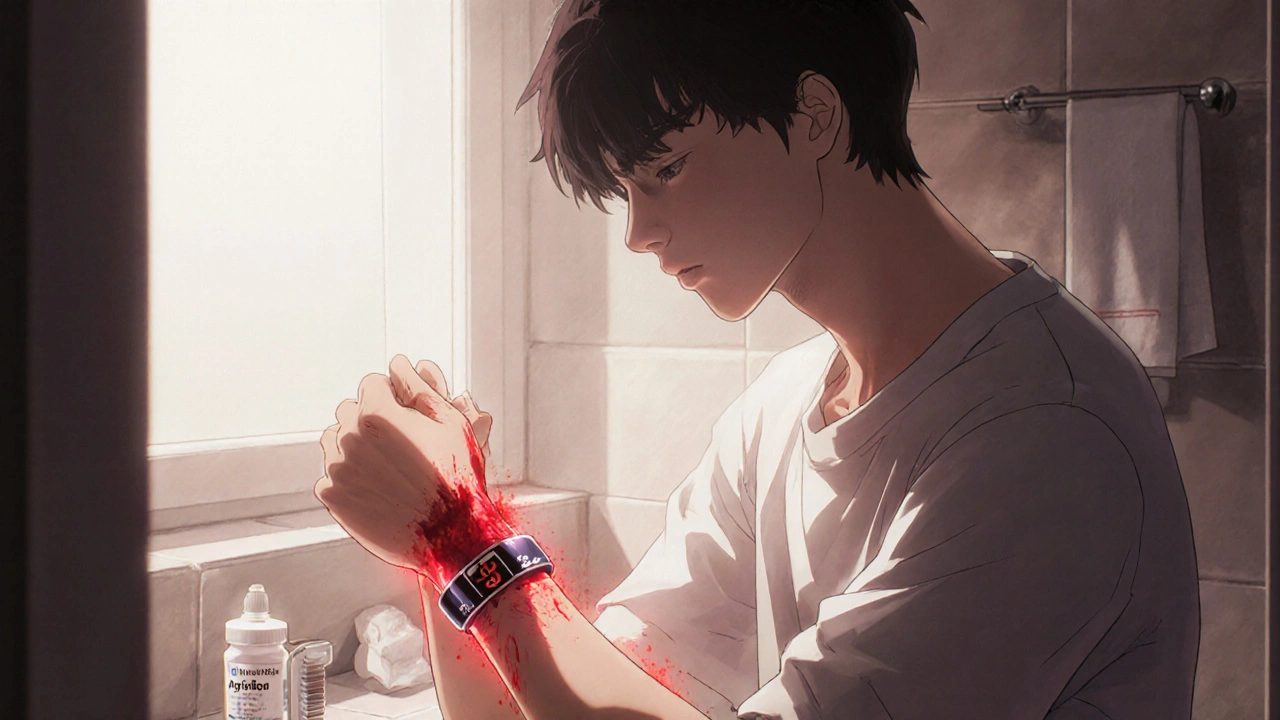
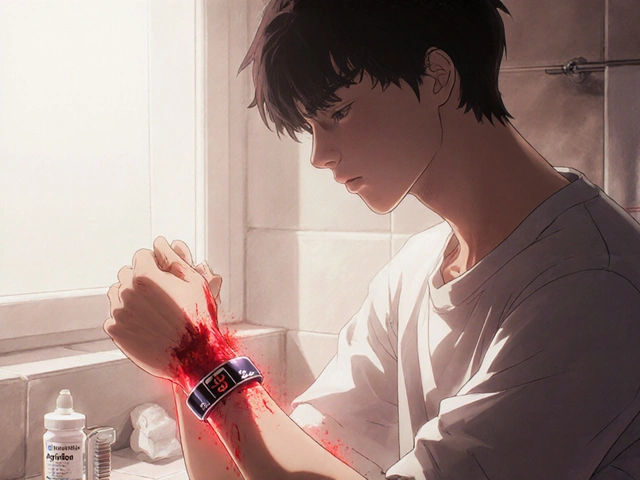

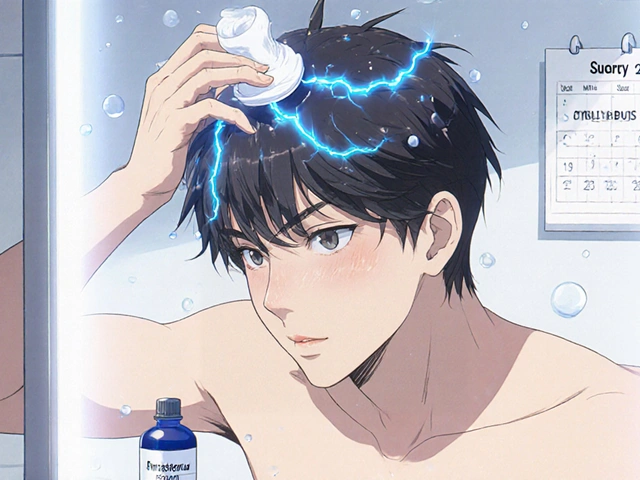
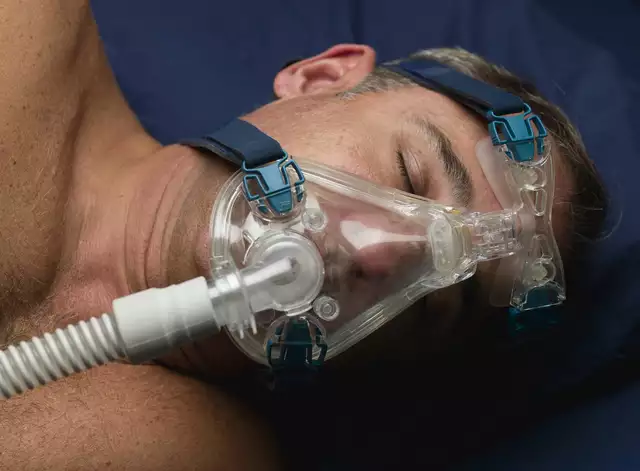

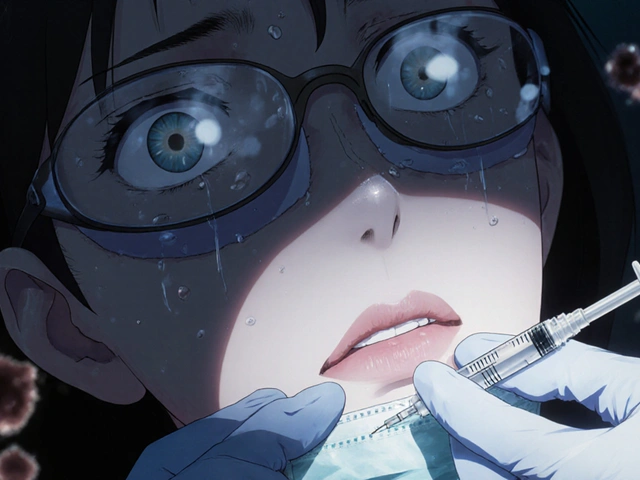
Comments
Just had a nosebleed last week that wouldn’t stop for 20 minutes-panicked like crazy. Read this and realized I did everything right: pinched, leaned forward, didn’t freak out. Still went to urgent care just to be safe. They laughed and said I was fine. But man, this article saved my sanity. Don’t let fear make you stupid. Know the signs, trust the process.
I’ve been on Xarelto for 3 years. Bruises everywhere. Once I got a tiny cut on my finger and it bled for 12 minutes. I sat there counting seconds like a robot. Turns out? Normal. I stopped Googling every little thing. Life’s better now.
So many people think blood thinners are dangerous when really they’re just different. Like driving a manual car vs automatic. You gotta learn the gears. The real danger? Stopping them cold turkey. That’s like unplugging your smoke detector because it went off once. You’re not safer-you’re just blind.
Let me guess-you’re the person who Googled ‘how to stop bleeding’ after a paper cut and then called 911? No? Just me? Okay. Good. Because if you’re reading this and still not sure whether to go to the ER, you’re probably the kind of person who needs to go to the ER. Just go. Stop being dramatic. But seriously-go.
I never realized how many people stop their meds after a small bleed. My mom did it after a bruise got too big. She had a stroke 3 weeks later. I wish someone had told her what this article says. Please share this with someone you love. It’s not just info-it’s a lifeline.
Okay I’m gonna say something wild-sometimes I forget I’m on a blood thinner. Like yesterday I was biking down a hill, didn’t wear a helmet, and didn’t even think about it. Then I remembered. And I didn’t stop biking. I just… remembered. And kept going. Because I’ve done the math. The risk of not taking it is way higher than the risk of falling. It’s not about living in fear. It’s about living with awareness. And yeah, sometimes that means carrying a medical bracelet like a badge of honor. Not a curse.
My dad’s on warfarin. He checks his INR every week. I asked him once if it’s worth it. He said ‘I’d rather check a needle than bury a coffin.’ That stuck with me. This article says the same thing. Just way more words.
Just got my first nosebleed on Eliquis… thought I was dying. Called my sister, she said ‘pinch it for 10 mins, don’t panic.’ I did. It stopped. Then I cried. Not from fear-from relief. This article is the calm voice I needed. Thank you.
Why do Americans make everything so complicated? Back in my country we just take the pill and don’t think about it. You people panic over a little blood. Get a grip. Stop watching so many medical dramas. You’re not in a hospital show.
Life is a gamble. Blood thinners? Just another roll of the dice. Some people win. Some lose. The article says ‘go to the ER’-but what if the ER is just another gamble? Maybe the real answer is… accept the randomness. Chill. Let go. The universe will sort it out. 🤷♂️
I started using an electric razor after reading this. Also switched to a soft toothbrush. And I actually feel more in control. It’s not about fear-it’s about smart habits. Small changes, big difference. Also, I made a printable bleeding plan with my doctor. It’s taped to my fridge. My kids know what to do now. That’s peace of mind.
My pharmacist gave me a card with all the emergency signs. I keep it in my wallet next to my insurance card. Last month I fell on the stairs-didn’t feel anything at first. Pulled out the card. Saw ‘head injury = go to ER’ and went. CT scan showed nothing. But I didn’t wait. And that’s the point. Don’t wait. Ever.
On apixaban since 2021. No issues. Minor cuts take 5-7 min. Nosebleeds stop with pressure. No ER needed. Just follow the rules. Simple.
And yet someone still thinks they can ‘chill’ through a brain bleed. No. Just no. If you’re reading this and you’re the type who says ‘I’ll wait and see’-you’re not brave. You’re just dumb. Go to the ER. Now. I’m not being sarcastic. I’m being serious. Your life isn’t a TikTok trend.